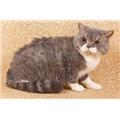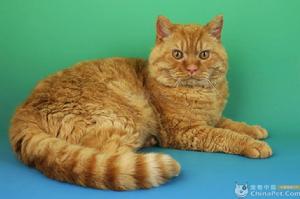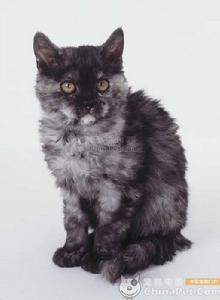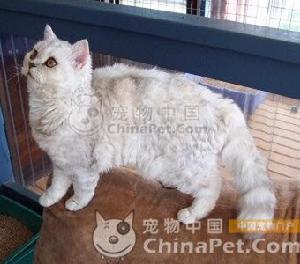 斯可可貓
斯可可貓別 名: 塞絲克貓
英文名: Selkirk Rex
體 重: (公)
(母)
大 小: (公)
原產地: 美國
貓種介紹
品種起源:
1987年在懷俄明州,一隻直發被毛的雌貓和一隻卷被毛的雄貓交配產下了一隻名為DEPESTOOFNOFACE小姐的貓,該貓遂為蒙大拿州的一位波斯貓育種專家JERI NEWMAN所收養。
1988年DEPESTO小姐和一隻名為PHOTO FINISH的黑色波斯貓交配產下了3隻卷被毛的小貓。後來它和自己的一隻幼崽交配又產下也只卷被毛性狀的幼崽。該品種的名稱來源於附近的SELKIRK山。
該品種的捲毛遺傳基因不同於其它品種的捲毛基因。德汶萊克斯形似外星來客,而SELKIRK萊克斯更象一隻牧羊犬。
它在美國已經普及,並於1990年進入歐洲,但至今在那裡仍然罕見。
性格特徵:
活躍,溫順,沉靜。和其它的貓以及狗相處融洽。愛玩耍,是孩子的良伴。溫柔,感情豐富,是令人愉悅的伴侶,非常適合公寓生活。
體形體重:
體型中等,在所有捲毛品種中體型最大,毛髮最豐富而粗糙,骨骼粗重,體重:2.5到6公斤。
毛色特徵:
所有的顏色都可以接受的。但明朗的顏色為佳,允許出現鎖扣
標準
體態特徵:
頭:大小中等,圓而寬。頭骨曲線微微凹陷。雌雄貓都長有滿月臉。吻部短而成角形。
鼻,微有鼻終止。毛和眉彎曲,雙下巴臃腫。
耳:大小中等,間隔大,耳尖微微起圓弧。耳內毛髮捲曲。
眼:大而圓,間距大,顏色均勻,並與被毛顏色相呼應。
頸:短而有肌肉感。
腿和爪:適度長,骨骼和肌肉中等到粗大,大而圓的爪。
尾:適度長,粗,尾尖呈圓形。
被毛:捲曲的毛髮之間間隙很大,捲曲的毛髮覆蓋全身,頸部和尾部的毛髮尤其濃密。沒有無毛區。低層絨毛豐富。被毛的捲曲程度和氣候、季節、性激素水平相關,對於雌貓來說尤其如此。小貓生來被毛捲曲,8到10個月大時它的捲毛舒並定型,2歲前被毛是一直生長的。有短毛和長毛變種。所有的顏色都可以接受的。但明朗的顏色為佳,允許出現鎖扣。
身體:適度長,長方形,粗壯而且笨重。肌肉發達,骨骼強壯。
目前允許雜交的品種:英國短毛貓、波斯貓、異國短毛貓
在2010以後1月被負擔的在或小貓1日,也許有僅Selkirk Rex或英國的Shorthair父母。
在2015以後1月被負擔的在或小貓1日,也許有僅Selkirk Rex父母。
失格:有鼻中斷,對眼,尾部纏節。
Breed Profile: Selkirk Rex
One of the newest natural breeds, this naturally curly cat originated from a housecat, Miss DePesto of Noface, found in a shelter in Montana. Given to Persian breeder, Jeri Newman of Montana, who bred her to PhotoFinish of Deekay, a black Persian. "Pest" produced three curly kittens out of six ?proving that unlike the Devon Rex and Cornish Rex, Pest's mutation was dominant. Because the gene is dominant, curly kittens can be born in the same litter with straight haired kittens.
The Selkirk Rex is being developed as a large, heavy boned cat rather like the British Shorthair in conformation. The head is round with no flat planes. The curl is plush and loosely curled, showing up more dramatically on the longhair. Selkirks are healthy and sturdy. They are an incredibly patient, loving, and tolerant cats. From the moment of birth, curly kittens can be distinguished from their straight haired littermates by their curly whiskers. The whiskers are brittle and may break as they grow longer. The whiskers and hair do not change as the cat grows older; if they are curly at birth, they are curly as an adult. Even if the coat later shows less curl, the cat has the curly gene and retains the curly whiskers.
A mature male or spayed female will have the best coat. In the best examples, the curling is strongest on the flanks, tummy and around the neck, with some curl on the back. The back of a Selkirk has the least amount of curl.
Selkirk Rexes come in two coat lengths: short and long. Each length has a separate division within the judging process. The care of the two different lengths of coats is similar to that of either a short or longhair coat. Brushing in either case should not be as frequent if the curly coat is to be maintained. Shampoos that do not coat the hair but leave the cat feeling silky and clean are the best to allow the hairs to curl.
This breed is not for the uptight organized pet owner. These cats' humans must be prepared to take all kinds of hair jokes such as: "The cat with the bad hair day." "Why don't you groom your cat," or "This cat is our dip and dry variety." Such comments lead to the hidden secret: they make you laugh. Although they may not always win the beauty pageant, they always win the title of Miss Congeniality.
Selkirk Rex owners are consistently stopped by people with anxious hands wanting to pet and feel this soft, plush pet. The fortunate humans are those who can take these live teddy cats home for cuddles and hugs.
Pricing on Selkirk Rex usually depends on type, applicable markings and bloodlines distinguished by Grand Champion (GC), National, National Breed and/or Regional winning parentage (NW, BW, RW) or of Distinguished Merit parentage (DM). The DM title is achieved by the dam (mother) having produced five CFA grand champion/premier (alter) or DM offspring, or sire (father) having produced fifteen CFA grand champion/premier or DM offspring. Usually breeders make kittens available between twelve and sixteen weeks of age. After twelve weeks, kittens have had their basic inoculations and developed the physical and social stability needed for a new environment, showing, or being transported by air. Keeping such a rare treasure indoors, neutering or spaying and providing acceptable surfaces (e.g. scratching posts) for the natural behavior of scratching (CFA disapproves of declawing or tendonectomy surgery) are essential elements for maintaining a healthy, long and joyful life.
Breed Standard: Selkirk Rex
POINT SCORE
HEAD (33)
11 ... Skull
11 ... Muzzle & chin
11 ... Ears and eyes
BODY (33)
15 ... torso
13 ... Legs and Feet
5 ... Tail
COAT (33)
33 ... Texture, Curl, Density
COLOR (1)
1... Including Eye Color
GENERAL: the Selkirk Rex is the result of a dominant, spontaneous mutation that causes each hair (guard, down and awn) to have a gentle curl giving the coat a soft feel. This is a medium to large cat with heavy boning that gives the cat surprising weight and an impression of power. Females may be less massive than males but not dainty in appearance. The Selkirk Rex is an active cat with a sweet and endearing personality. Balance and substance are the essence of the breed, where all parts come together in harmonious whole with neither too much nor too little consideration given to any one feature.
HEAD:Skull: round, broad and full-cheeked in both males and females. Skull structure to be smooth and round to the touch from the stop to the back of the head as well as across the breadth of the forehead and between the ears. Muzzle: the muzzle is medium width. The underlying bone structure is rounded with well-padded whisker pads to give the impression of squareness. The length is equal to 1/2 the width. Profile shows a muzzle, clearly visible beyond the curve of the cheek. The tip of the chin lines up with the tip of the nose and the upper lip in the same vertical plane. Profile reveals a nose stop. The nose has a downward slant with a convex curve and is set below the eye line. Chin: firm and well-developed, balanced in proportion to the rest of the head and should be neither receding, protruding, nor excessively massive. Either level or scissors bite is considered correct (level bite - top and bottom front teeth meet evenly. Scissors bite - inside edge of top front teeth touch outside edge of lower front teeth). Ears: medium in size, broad at the base, tapering, set well apart. Should fit into (without distorting) the rounded contour of the head. Furnishings, if present, are curly. Eyes: large, rounded, set well apart. The eyes should not appear almond or oval-shaped. The outside corner is set very slightly higher than the inner corner, giving a sweet open expression to the face.
BODY: Torso: medium to large and well-balanced. The substantial muscular torso is more rectangular than square, but not long. Back is straight with a slight rise to the hindquarters. Shoulders and hip should appear to be the same width. Legs: medium to long. Substantial boning. Should be in proportion to the body. Feet: large, round, and firm. Toes: five in front, four behind. Tail: medium length, proportionate to body. Heavy at base, neither blunt nor pointed at tip.
COAT: Coat length: two lengths - short and long. The differences in coat length are most obviously seen on the tail and ruff. On the shorthairs the tail hair is the same length as the coat (approximately 1"-2") and tail curls are plush and lie compactly around the tail. The ruff is the same length as the coat fur. On the longhairs, the tail curls are plumy and stand out away from the tail. The ruff hairs are also longer and frame the face.
SHORTHAIR- Texture: the coat texture is soft, plushy, full and obviously curly. Density: the coat is dense and full with no bald or thinly covered areas of the body. The coat stands out from the body and should not appear flat or close-lying. Curl: this is a random, unstructured coat, arranged in loose, individual curls. The curls appear to be in "clumps" rather than as an all over wave. Although curl varies by hair length, sex and age in an individual, the entire coat should show the effect of the rex gene. Curliness may be evident more around the neck, on the tail and the belly. Allowance should be made for less curl on younger adults and kittens.
LONGHAIR - Texture: the coat texture is soft, full, and obviously curly. It does not feel or appear to be as plush as the shorthair coat, however, should not appear to be thin. Density: the coat is dense and full with no bald or thinly covered areas of the body. The coat may stand out from the body but may appear and feel less than plush, but not close-lying. Curl: this is a random, unstructured coat, arranged in loose, individual curls. The curls appear to be in "clumps" or "ringlets" rather than as an all over wave. Although curl vaires by hair length, sex and age in an individual, entire coat should show the effect of the rex gene. Curliness may be evident more around the neck, on the tail and the belly. Allowance should be made for less curl on younger adults and kittens.
PENALIZE: Excessive cobbiness or sleek oriental appearance.
DISQUALIFY: Extreme nose break, lack of visible muzzle, malocclusion, tail kinks, crossed eyes, obvious physical deformities, including polydactl feet, no evidence of curl.
SELKIRK REX COLORS
COAT COLOR: any genetically possible color or combination of colors is allowed. EYE COLOR: any eye color is acceptable.
WHITE: pure glistening white. Nose leather and paw pads: pink.
BLACK: dense coal black from roots to tip of fur. Nose leather and paw pads: black.
BLUE: one level tone most important, light shade preferred. Nose leather and paw pads: blue.
RED/RED tabby: ground color deep with or without tabby markings or ticking. Lips and chin same as coat. Nose leather and paw pads: brick red.
CREAM/CREAM TABBY: warm cream with or without tabby markings. Nose leather and paw pads: pink.
CHOCOLATE: rich, warm chocolate-brown, one level tone. Nose leather and paw pads: brown.
LAVENDER: one level shade, frosty pink. Nose leather and paw pads: lavender pink.
SHADED PATTERN: undercoat white with a mantle of specified marking color tipping shaded down from sides, face and tail from dark on the ridge to white on the chin, stomach and under the tail. Legs to be the same tone as the face. Rims of eyes, lips and nose outlined with marking color. Nose leather and paw pads as defined below.
SHADED SILVER: Nose leather: brick red. Paw pads: black.
BLUE SHADED: Nose leather and paw pads: blue or blue with pink tone.
CHOCOLATE SHADED: Nose leather: pink. Paw pads: cinnamon.
LAVENDER SHADED: Nose leather and paw pads: lavender pink.
CAMEO SHADED: Nose leather and paw pads: rose.
tortoiseshell SHADED: Nose leather and paw pads: as in the solids, may be mottled with pink.
BLUE-CREAM SHADED: Nose leather and paw pads: as in solids, may be mottled with pink.
CHOCOLATE TORTOISESHELL SHADED: Nose leather and paw pads: as in solids, may be mottled with pink.
LAVENDER-CREAM SHADED: Nose leather and paw pads: as in solids, may be mottled with pink.
GOLDEN SHADED: undercoat rich warm cream Nose leather: deep rose. Paw pads: black.
chinchilla PATTERN: undercoat pure white. Coat on back, flanks, head and tail sufficiently tipped with specific marking color (i.e., black, blue, red, cream, tortoiseshell, etc.) to give the characteristic sparkling appearance. Legs may be slightly shaded with tipping. Chin, stomach and chest, pure white. Rims of eyes, lips and nose outlined with marking color. Nose leather: appropriate to pattern and marking color (black/brick red; blue/old rose; etc.). Paw pads: appropriate to pattern and marking color.
GOLDEN CHINCHILLA: undercoat rich warm cream, tipped as for other chinchilla colors. Nose leather and paw pads: appropriate to marking color
SMOKE PATTERN: white undercoat more deeply tipped with specified marking color. Cat in repose appears to be of marking color. In motion, the white undercoat is apparent. Points and mask of marking color with narrow band of white at base of hairs next to skin which may be seen only when fur is parted. Nose leather and paw pads: appropriate to pattern and marking color (see below).
BLACK SMOKE: Nose leather and paw pads: black.
BLUE SMOKE: Nose leather and paw pads: blue.
RED SMOKE CAMEO: Nose leather and paw pads: rose.
CHOCOLATE SMOKE: Nose leather and paw pads: brown or brick.
LAVENDER SMOKE: Nose leather and paw pads: lavender pink.
CREAM SMOKE: Nose leather and paw pads: pink.
TORTOISESHELL SMOKE: Nose leather and paw pads: mottled with pink on nose and paws.
BLUE-CREAM SMOKE: Nose leather and paw pads: mottled with pink on nose and paw pads.
CHOCOLATE TORTOISESHELL SMOKE: Nose leather and paw pads: mottled with pink on nose and paws.
LAVENDER-CREAM SMOKE: Nose leather and paw pads: mottled with pink on nose and paws.
CLASSIC TABBY PATTERN: markings dense, clearly defined and broad. Legs evenly barred with bracelets coming up to meet the body markings. Tail evenly ringed. Several unbroken necklaces on neck and upper chest, the more the better. frown marks on the forehead form intricate letter "M". Unbroken line runs back from outer corner of eye. SWIRLS on cheeks. Vertical lines over back of head extend to shoulder markings which are in the shape of a butterfly with both upper and lower wings distinctly outlined and marked with dots inside outline. Back markings consist of a vertical line down the spine from butterfly to tail with a vertical stripe paralleling it on each side, the three stripes well separated by stripes of ground color. Large solid blotch on each side to be encircled by one or more unbroken rings. Side markings should be the same on both sides. Double vertical row of buttons on chest and stomach.
mackerel TABBY PATTERN: markings dense, clearly defined and all narrow pencillings. Legs evenly barred with narrow bracelets coming up to meet the body markings. Tail barred. Necklaces on neck and chest distinct; like so many chains. Head barred with an "M" on the forehead. Unbroken lines running back from the eyes. Lines running sown the head to meet the shoulders. Spine lines run together to form a narrow saddle. Narrow pencillings run around body.
SPOTTED TABBY PATTERN: markings on the body to be spotted. Spots can be round, oblong or rosette-shaped. Any of these are of equal merit but the spots, however shaped or placed, should be distinct. Spots should not run together in a broken mackerel pattern. A dorsal stripe runs the length of the body to the tip of the tail. The stripe is ideally composed of spots. The markings of the face and forehead shall be typically tabby markings. Underside of the body to have "vest buttons". Legs and tail are barred.
PATCHED TABBY PATTERN: a patched tabby (torbie) is an established silver, brown, blue, red, cream, etc. tabby with patches of red, cream, lavender, etc. clearly defined on both the body and extremities; a blaze on the face is desirable.
SILVER TABBY: ground color, including lips and chin, pale clear silver. Markings dense black. Nose leather: brick red. Paw pads: black.
BROWN TABBY: ground color brilliant coppery brown. Markings dense black. Lips and chin the same shade as around the eyes. Back of legs black from paw to heel. Nose leather: brick red. Paw pads: black or brown. LUE TABBY: ground color, including lips and chin, pale bluish ivory. Markings a very Deep Blue affording a good contrast with ground color. Warm fawn overtones or patina over the whole. Nose leather: old rose. Paw pads: rose.
CHOCOLATE TABBY: ground color is warm fawn, markings are rich chestnut brown. Nose leather: chestnut or pink rimmed with chestnut. Paw pads: cinnamon.
CHOCOLATE SILVER TABBY: ground color, including lips and chin, is silver. Markings rich chestnut. Nose leather: chestnut, or pink rimmed with chestnut. Paw pads: coral.
LAVENDER TABBY: ground color is pale lavender. Markings are a rich lavender, affording good contrast with ground color. Nose leather: lavender, or pink rimmed with lavender. Paw pads: lavender-pink.
LAVENDER SILVER TABBY: ground color, including lips and chin a cold, clear silver. Markings solid lavender. Nose leather: lavender or pink rimmed with lavender. Paw pads: lavender-pink.
CAMEO TABBY: ground color off-white. Markings red. Nose leather and paw pads: rose.
BLUE-SILVER, CREAM-SILVER TABBY: tabby pattern with colors and leathers same as for corresponding shaded colors.
TORTOISESHELL: black mottled with red. Red areas may or may not show tabby markings.. Blaze on face is desirable.
BLUE-CREAM: blue mottled or patched with cream. Cream areas may or may not show tabby markings. Blaze on face is desirable.
CHOCOLATE TORTOISESHELL: rich chestnut brown mottled or patched with red and/or cream. Red areas may or may not show tabby markings. Blaze on face is desirable.
LAVENDER-CREAM: lavender mottled or patched with cream. Cream areas may or may not show tabby markings. Blaze on face is desirable.
calico: white with unbrindled patches of black and red. Red areas may or may not show tabby markings. White predominant on underparts. Any combination of dominant colors of solid, tabby, smoke or shaded and white. Also colorpoint.
VAN CALICO: white cat with patches of dominant colors (see CALICO) confined to the extremities; head tail and legs. One or two small patches of color on body allowable. Also colorpoint.
DILUTE CALICO: white with unbrindled patches of dilute colors in solid, tabby, smoke or shaded. Cream patches may or may not show tabby markings. White predominant on underparts. Also colorpoint.
VAN DILUTE CALICO: white cat with unbrindled patches of dilute colors in solid, tabby, smoke or shaded. Color confined to the extremities; head, tail, legs. One or two small patches of color on body allowable. Also colorpoint.
BI-COLOR: solid color and white, tabby and white, smoke and white, shaded and white, colorpoint and white. VAN BI-COLOR: solid color and white, tabby and white, smoke and white, shaded and white, colorpoint and white. Color confined to extremities: head, legs, tail. One or two small patches on body allowable.
SEAL POINT: body even pale fawn to cream, warm in tone, shading gradually into lighter color on the stomach and chest. Points deep seal brown. Nose leather and paw pads: seal brown.
CHOCOLATE POINT: body ivory with no shading. Points milk chocolate color, warm in tone. Nose leather and paw pads: cinnamon pink.
BLUE POINT: body bluish-white, cold in tone, shading gradually to white on stomach and chest. Points blue. Nose leather and paw pads: slate blue.
LILAC POINT: body glacial white with no shading. Points frosty grey with pinkish tone. Nose leather and paw pads: lavender pink.
LILAC-CREAM POINT: body glacial white with no shading. Points lilac with patches of cream. Nose leather and paw pads: lavender pink, pink or combination of pink and lavender pink.
FLAME (RED) POINT: body creamy white. Points deep orange flame to deep red. Nose leather and paw pads: flesh or coral pink.
CREAM POINT: body creamy white with no shading. Points buff cream with no apricot. Nose leather and paw pads: flesh pink or salmon coral.
TORTIE POINT: body creamy white or pale fawn. Points seal with unbrindled patches of red and/or cream. Blaze of red or cream on face desirable. Nose leather and paw pads: seal brown with flesh and/or coral pink mottling to conform with colors on points.
CHOCOLATE-TORTIE POINT: body ivory with no shading. Points chocolate with unbrindled patches of red and/or cream Nose leather and paw pads: chocolate with flesh and/or coral pink mottling to conform with point color.
BLUE-CREAM POINT: body bluish white or creamy white, shading gradually to white on the stomach and chest. Points blue with patches of cream. Nose leather and paw pads: slate-blue, pink or a combination of slate-blue and pink.
SILVER POINT: body ivory to glacial white. Points shaded silver. Rims of eyes, lips and nose outlined with black. Nose leather: brick red. Paw pads: black.
LYNX POINTS: body color appropriate to marking and ground color. Mask must be clearly lined with dark stripes vertical on forehead with classic "M" on forehead, horizontal on cheeks and dark spots on whisker pads clearly outlined in dark color edges. Inner ear light with thumbprint on outer ear. Markings dense, clearly defined and broad. Legs evenly barred with bracelets. Tail barred. No striping or mottling on body, but consideration given to shading in older cats.
SEAL LYNX POINT: Nose leather: seal or brick red. Paw pads: seal.
BLUE LYNX POINT: Nose leather: blue or brick red. Paw pads: blue.
CHOCOLATE LYNX POINT: Nose leather and paw pads: cinnamon, or pink rimmed with cinnamon.
LILAC LYNX POINT: Nose leather and paw pads: lavender pink or pink rimmed with lavender.
FLAME (RED) LYNX POINT: Nose leather and paw pads: flesh or coral pink or red.
CREAM LYNX POINT: Nose leather and paw pads: pink or pink rimmed with salmon coral.
SILVER LYNX POINT: Nose leather: coral pink or brick red lined with black. Paw pads: black or seal.
NATURAL MINK: body medium brown, shading to lighter hue on the underparts. Ruddy highlights acceptable. Points are dark brown. Nose leather: dark brown corresponding to the intensity of the point color. Paw pads: medium to dark brown (may have rosy undertone).
CHAMPAGNE MINK: body buff-cream, points medium brown. Nose leather: cinnamon-brown. Paw pads: cinnamon-pink to cinnamon-brown.
BLUE MINK: body blue-grey, shading to lighter hue on the underparts. Fawn overtones permissible. Points slate blue, distinctly darker than body color. Nose leather and paw pads: slate grey (may have rosy undertone).
PLATINUM MINK: body pale, silvery grey with warm overtones. Not white or cream. Points pewter-grey, distinctly darker than the body color. Points may have a lavender cast due to the color of the skin underneath. Nose leather: lavender-pink to lavender-grey. Paw pads: lavender-pink.
SABLE SEPIA: rich warm sable brown, shading almost imperceptibly to a slightly lighter hue on the underparts, but otherwise without shading, barring or markings of any kind (kittens are often lighter in color). Nose leather and paw pads: brown.
CHAMPAGNE SEPIA: warm honey beige, shading to a pale golden tan underside. Slight darkening on ears and face permissible. Nose leather: light warm brown. Paw pads: warm pinkish tan.
BLUE SEPIA: medium blue with warm fawn undertones, shading almost imperceptibly to a slightly lighter hue on the underparts, but otherwise without shading, barring or marking of any kind. Nose leather and paw pads: slate grey.
PLATINUM SEPIA: pale, silvery grey with pale fawn undertones, shading almost imperceptibly to a slightly lighter hue on the underparts, but otherwise without shading, barring or markings of any kind. Nose leather and paw pads: lavender pink.
OSRC (OTHER SELKIRK REX COLORS): any other genetically possible color or pattern. Cats with no more than a locket and/or button do not qualify for this class; such cats shall be judged in the color class of their basic color with no penalty for such locket or button.
The following information is for reference purposes only and not an official part of the CFA Show Standard.
Selkirk Rex Color Class Numbers
Longhair Division
All Championship Colors 5700 5701
(All accepted colors as defined in the
Show Standards.)
AOV 5798 5799
Shorthair Division
All Championship Colors 4700 4701
(All accepted colors as defined in the
Show Standards.)
AOV 4798 4799
Selkirk Rex allowable outcross breeds: British Shorthair, Persian, or Exotic. Kittens born on or after January 1, 2010 may have only Selkirk Rex or British Shorthair parents. Kittens born on or after January 1, 2015 may have only Selkirk Rex parents.
相關圖片
 斯可可貓
斯可可貓 斯可可貓
斯可可貓 斯可可貓
斯可可貓